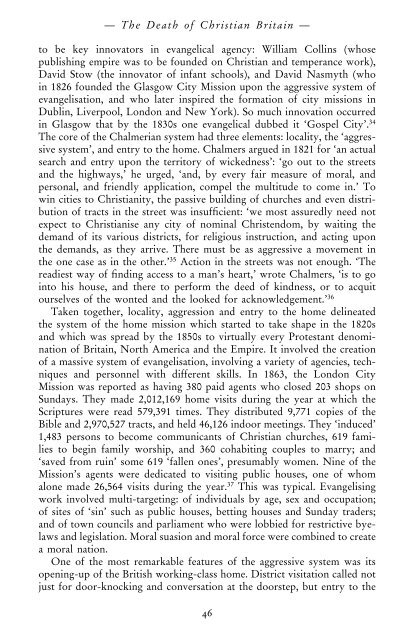The Death of Christian Britain
The Death of Christian Britain
The Death of Christian Britain
Create successful ePaper yourself
Turn your PDF publications into a flip-book with our unique Google optimized e-Paper software.
— <strong>The</strong> <strong>Death</strong> <strong>of</strong> <strong>Christian</strong> <strong>Britain</strong> —<br />
to be key innovators in evangelical agency: William Collins (whose<br />
publishing empire was to be founded on <strong>Christian</strong> and temperance work),<br />
David Stow (the innovator <strong>of</strong> infant schools), and David Nasmyth (who<br />
in 1826 founded the Glasgow City Mission upon the aggressive system <strong>of</strong><br />
evangelisation, and who later inspired the formation <strong>of</strong> city missions in<br />
Dublin, Liverpool, London and New York). So much innovation occurred<br />
in Glasgow that by the 1830s one evangelical dubbed it ‘Gospel City’. 34<br />
<strong>The</strong> core <strong>of</strong> the Chalmerian system had three elements: locality, the ‘aggressive<br />
system’, and entry to the home. Chalmers argued in 1821 for ‘an actual<br />
search and entry upon the territory <strong>of</strong> wickedness’: ‘go out to the streets<br />
and the highways,’ he urged, ‘and, by every fair measure <strong>of</strong> moral, and<br />
personal, and friendly application, compel the multitude to come in.’ To<br />
win cities to <strong>Christian</strong>ity, the passive building <strong>of</strong> churches and even distribution<br />
<strong>of</strong> tracts in the street was insufficient: ‘we most assuredly need not<br />
expect to <strong>Christian</strong>ise any city <strong>of</strong> nominal Christendom, by waiting the<br />
demand <strong>of</strong> its various districts, for religious instruction, and acting upon<br />
the demands, as they arrive. <strong>The</strong>re must be as aggressive a movement in<br />
the one case as in the other.’ 35 Action in the streets was not enough. ‘<strong>The</strong><br />
readiest way <strong>of</strong> finding access to a man’s heart,’ wrote Chalmers, ‘is to go<br />
into his house, and there to perform the deed <strong>of</strong> kindness, or to acquit<br />
ourselves <strong>of</strong> the wonted and the looked for acknowledgement.’ 36<br />
Taken together, locality, aggression and entry to the home delineated<br />
the system <strong>of</strong> the home mission which started to take shape in the 1820s<br />
and which was spread by the 1850s to virtually every Protestant denomination<br />
<strong>of</strong> <strong>Britain</strong>, North America and the Empire. It involved the creation<br />
<strong>of</strong> a massive system <strong>of</strong> evangelisation, involving a variety <strong>of</strong> agencies, techniques<br />
and personnel with different skills. In 1863, the London City<br />
Mission was reported as having 380 paid agents who closed 203 shops on<br />
Sundays. <strong>The</strong>y made 2,012,169 home visits during the year at which the<br />
Scriptures were read 579,391 times. <strong>The</strong>y distributed 9,771 copies <strong>of</strong> the<br />
Bible and 2,970,527 tracts, and held 46,126 indoor meetings. <strong>The</strong>y ‘induced’<br />
1,483 persons to become communicants <strong>of</strong> <strong>Christian</strong> churches, 619 families<br />
to begin family worship, and 360 cohabiting couples to marry; and<br />
‘saved from ruin’ some 619 ‘fallen ones’, presumably women. Nine <strong>of</strong> the<br />
Mission’s agents were dedicated to visiting public houses, one <strong>of</strong> whom<br />
alone made 26,564 visits during the year. 37 This was typical. Evangelising<br />
work involved multi-targeting: <strong>of</strong> individuals by age, sex and occupation;<br />
<strong>of</strong> sites <strong>of</strong> ‘sin’ such as public houses, betting houses and Sunday traders;<br />
and <strong>of</strong> town councils and parliament who were lobbied for restrictive byelaws<br />
and legislation. Moral suasion and moral force were combined to create<br />
a moral nation.<br />
One <strong>of</strong> the most remarkable features <strong>of</strong> the aggressive system was its<br />
opening-up <strong>of</strong> the British working-class home. District visitation called not<br />
just for door-knocking and conversation at the doorstep, but entry to the<br />
46








